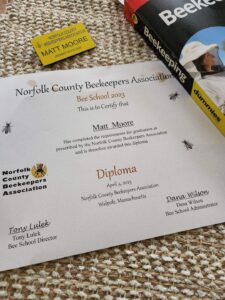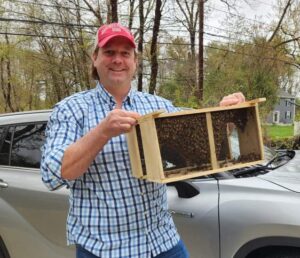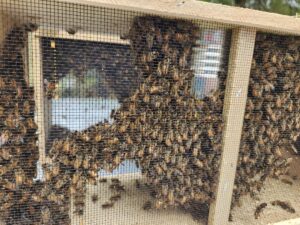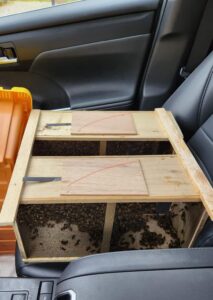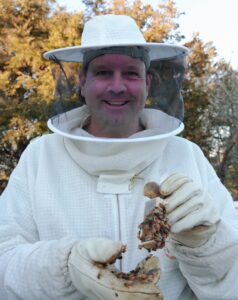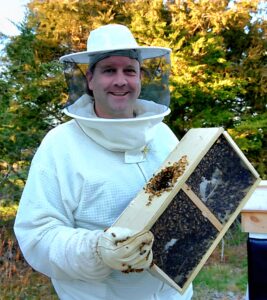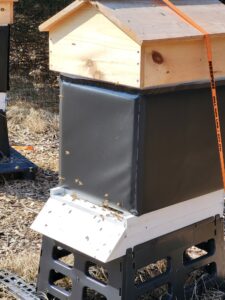Welcome to the Winnetu Bee Journal!
Stay updated on the activity of our hives from Matt Moore, our resident Beekeeper and General Manager of the Winnetu Oceanside Resort. Read more about our beehive operation here.
April 15, 2024
This season, we were fortunate to be able to purchase Buckfast Bees, a subspecies hybrid of honeybees developed and introduced last century by Christian monks at the Buckfast Abby in the UK. The Buckfast have a propensity to be very easy to handle, calm disposition, do well in cooler climates and are very productive bees.
These new arrivals were raised in Central Massachusetts and, more importantly, come from an “overwintered” stock. This is important because the queen’s genetics are adapted to the cold New England winters vs. her cousins raised in apiaries in southern climates like Georgia, Florida, Texas or California. Thus, they are more likely to survive in New England.
The package is a micro hive consisting of 3 lbs of bees [approximately 12,000] and a queen, who was typically raised from another hive. Because of this and to help ensure her acceptance she is held separately in her own queen cage. Inside the wooden box with the screened sides, there’s is also a metal can of sugar syrup to help feed them along the journey which is generally 2-5 days.
The conventional wisdom here is that once you introduce the bulk of the bees to their new hive, you insert the queen cage amongst the frames of honeycomb her powerful pheromones will introduce her to her subjects over the course of time. This brief separation of the incarcerated queen helps in two ways: 1) its mitigates the risk the hive will reject and kill her. 2) it reduces the risk that the queen simply flies away and abandons the hive during the transfer process, which would doom the emerging hive.
The queen cage has a sugar fondue “cork” keeping her from escaping, typically it will take 1-3 days for the queen and her subjects to chew through the cork to release her. Once free, we expect her to start laying eggs immediately.
April 11, 2024
In prepping for our new arrivals next week, I was able to salvage some honey from a few frames from the empty hive. Expectations were low as the frames were fully built out with honeycomb, but only maybe 40-70% full with honey. Surprisingly was able to get 13 (4oz) jars of honey. The process is pretty easy, but as you can imagine messy. You need a tool first to uncap the honey. I used both a scrapper and a prickly roller to see what worked better. I think I was more comfortable with the roller, as the scrapper took a little too much honey in addition to the wax. Then I place the uncapped honey into the extractor and spun it out for 3 minutes on each side. The extractor frees the honey from the comb by using centrifugal force and collects at the bottom of the metal extractor. This then gets strained through a very fine metal sieve that helps keep any particles or wax cap out of the finished product. Once filtered, that finished product goes into a honey bucket that has a pouring gate that makes it easy to jar.
Stickers are in development for the jars, which will be on sale in the Winnetu General Store this summer. Next honey collection will be late June or early July.
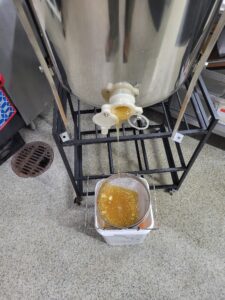
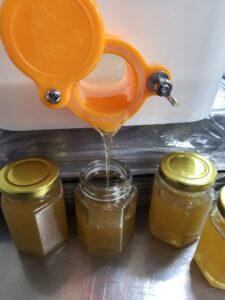
February 27, 2024
As expected, a lot of activity on mid 50’s day in February. Bees ventured out after being cooped up in the hive for the last 3 months. While some foraged – believe it or not, witchhazel is already in bloom and trees like Oak, Juniper, Elm & Birch are just starting to pollenate. Most bees also used the moderate weather to do what’s called a cleansing flight (restroom break). The solid sugar fondant put in back in November as a supplemental energy source to their stored honey is almost completely eaten so 2 more were added to the hive. This will give them the energy they need until March when they can regularly start to forage outside the hive. Important to point out the use of solid sugar (winter feed) vs. a liquid sugar (spring and fall feed) as a supplement to ensure fewer cleansing flights are needed with winter not over yet.
_________________________________________________________________________________________________________________________________________________
February 7, 2024
Massachusetts State Apiary Inspectors were out to The Vineyard today to inspect the “dead-out” on the west colony. Good news is that nothing traumatic was found…except the dead bees. Stored honey supply was good, varroa mite test found 2 per 300 – very much at acceptable levels. Interestingly there was a lot of queen cells which are larger than a typical bee cell – that are very distinctive, like a shelled peanut attached on the honeycomb and a lot of drones (males).
The suspicion is that the queen was laying drones at a much higher percentage than worker bees (especially too late into the fall) and it threw off the colony’s equilibrium. This is a significant finding, as typically drones make up only 15%-20% of a colony population, the dead hive looked to have double that number. Those drones have one job: mate with a queen. Other than that, they are useless, they can’t protect the hive, forage or make honey. They just end up taking away resources from the rest of the workers that are vital to the colony in surviving winter.
Bee evolution is pretty incredible. In a last-ditch attempt to save the hive, once they realized the problem existed with the drones, the worker bees take it on their own to supersede the existing queen – they started converting worker bee larvae into queen bees. Ideally, once a dominate superseding queen is hatched and starts laying the brood, the existing queen would be killed. Unfortunately, it was too late in the season to refortify the colony with “fat” worker bees for the winter season. I presume that the hive died after that first artic blast we had in late December when they didn’t have enough of a critical mass of worker bees to maintain a core hive temperature enabling them to survive a New England winter.
_________________________________________________________________________________________________________________________________________________
January 31, 2024
Dead bees at the entrance in winter are actually a good sign as the colony is still strong enough to do basic housekeeping like mortuary duties removing bees that recently died.
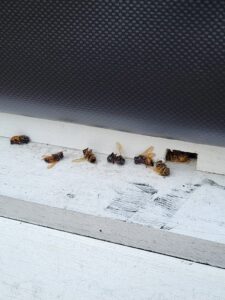
________________________________________________________________________________________
January 23, 2024
Bees in the east colony are thriving in spite of excessive freezing temperatures this past week. Interesting to see them “festooning”. They normally only chain-link together like this when building honeycomb. It is estimated that they need to get through another 5 weeks before the Queen starts laying eggs for the 2024 spring forage season.
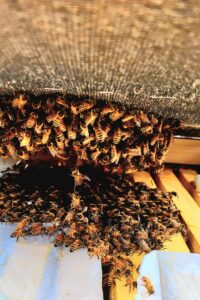
________________________________________________________________________________________
January 6, 2024
Checked on the bees this week unfortunately one colony has died out. Fortunate to have the state apiary inspector scheduled to check it in February to do a post mortem including lab testing to learn why they died. The other colony is doing well. Got a cool picture of them with one bee in mid flight. Another picture is a dead bee still standing upright.
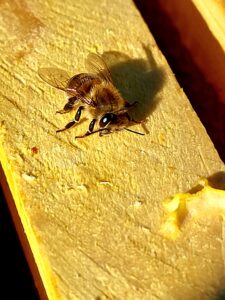
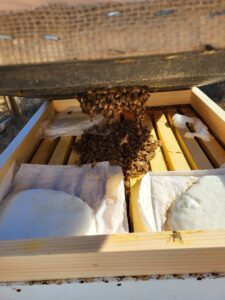
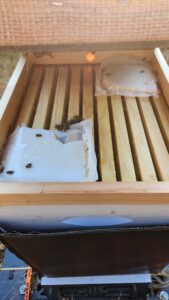
________________________________________________________________________________________
December 13, 2023
Took advantage of a mild winter day to check on the hives. East Hive doing well, numbering easily in the thousands. West hive, as suspected definitely on life support. I estimate only a hundred left. Stange to see the healthy hive operating as a single organism balling for essential heat, while the dysfunctional hive has lost that instinct and appears to be working solely as individuals. The less they work as a community, the worse they do. Great lesson for mankind.
Added insulated outer covers that wrap around the hive and attaches with Velcro for winter. It will act as a wind break from the gusts blowing off the ocean, the R4 fiberglass inserts will help warm the hive body as will the thermal heating from the fabric absorbing the sun. Bees can still come and go as they need.
Sugar fondue I put in a month ago still plentiful and should last another 8-10 weeks I suspect. It will be used as a supplement to their stored honey.
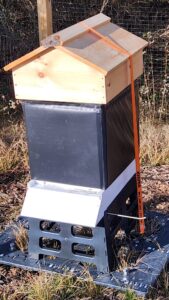
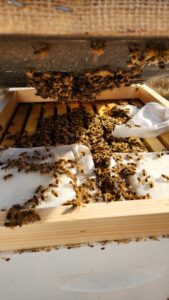
________________________________________________________________________________________
November 10, 2023
Bees are put to bed for the season. Most of the drones [pictured are bigger than average bee size with the very large eyes] have been banished or killed. Amazing to see the workers chasing the males out of the hive the last few weeks. It’s nature’s way of ensuring the colony survives winter with only “essential employees” who are responsible for keeping the hive alive until spring.
50% winter survival rate is normal and there are so many variables at play – number of fat bees reared at end of brood season, honey storage, external temperatures, moisture control, mite control and of course the queen’s survival just to name a few. East hive is thriving and has 9 full frames of honey stored. West hive is dramatically less maybe 2,000 bees in it with very little stored honey. Odds are against them it appears. We didn’t harvest any honey this year to give them their best chance at survival in theory for the first year. Added a sugar fondant that will provide supplemental fuel they will need for the winter and replaced throughout winter as needed.
There are so many differing opinions on how to winter bees. After a lot of research we found plans for a Quilt Box that made the most logical sense. Joe from our engineering team enthusiastically and expertly built it. It’s filled with pine shavings that will help control moisture generated by the thermoregulating cluster the bees form to keep the hive amazing close to 90 degrees until spring. The theory behind the design is to moderate the temperature and moisture allowing the bees to conserve their energy and thus their energy stores. The pitched roof design vs flat will help wick any ceiling condensation away from the cluster and provide just enough ventilation via the eaves. This novice beekeeper is hoping for a miracle here
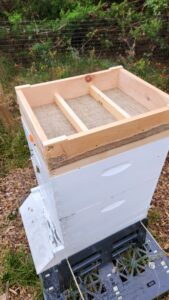
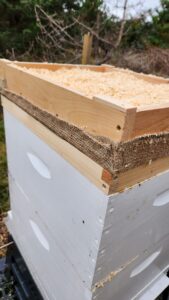
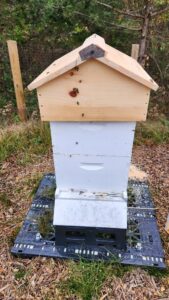
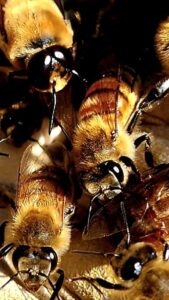
_________________________________________________________________________________________________________________________________________________
World Bee Day, May 20, 2023
Fun Fact: Bees are being used to study dementia. When a bee takes on a new job that is usually done by a younger bee, its brain stops aging.
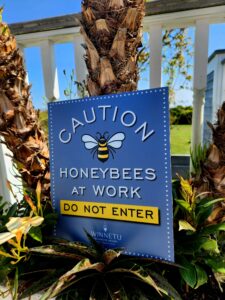
_________________________________________________________________________________________________________________________________________________
May 1, 2023
Back on Island for the season, this time with some very special guests. It has been said the key to a fulfilling life is to continue to stay out of your comfort zone and learn new things. Well in my 50th year, I am now proud to announce an additional title to add to my professional resume – Certified Beekeeper. Excited to work with these two colonies and assist them while they grow and flourish from an individual package of 8,000 to 60,000+ strong this summer. Many thanks to Todd Barker of Barkers Beehives & Supplies; Edwin Medrano an old colleague and friend from the Seaport Hotel – a fantastic keeper of bees; as well as the Norfolk County Beekeepers Association for the education and encouragment these past 4 months. Much more to come. #mvbeekeeping
